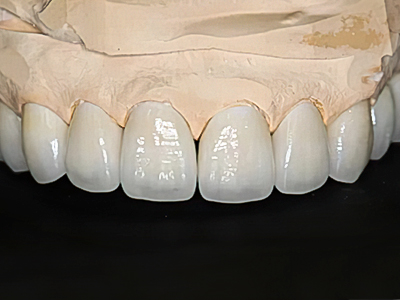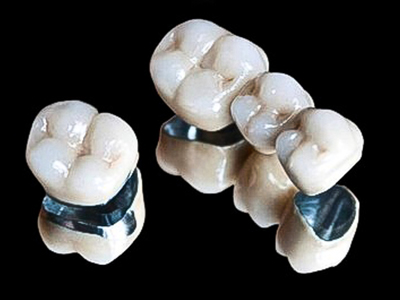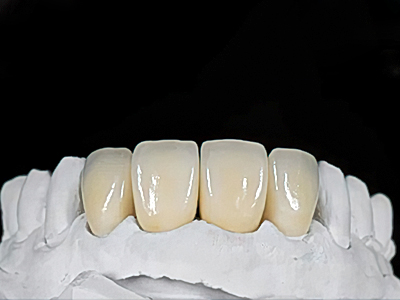Dental Crowns
Dental Crowns
can be an effective treatment option for tooth that are badly damaged. The dental crown procedure utilizes tooth-shaped coverings made of metal, zirconia, or porcelain to improve the appearance, restore the strength and eliminate the discomfort.
Treatment time can take 2-3 visits with total of 10 days.
Benefits of Crowns and Caps
Covers discolored and irregularities in teeth in improving cosmetic appearance
Protects severely damaged tooth or tooth weakened by decay, fracture, large fillings or root canal therapy from fracturing. Teeth with large fillings tend to “flex more” forcing the tooth apart possibly causing stress fractures
Holds together cracked or weaken teeth and seal the tooth from decay
Helps preserve the natural function and position of the teeth
Restores tooth with large decay, cavities or fillings
Supports the replacement teeth in a bridge
Restores and maintains natural bite
Covers a dental implant
Types of
Dental Crown
Dental crowns are made of metal, ceramic, porcelain fused to metal or composite/polymer. The type of crown utilized during your dental crown procedure will depend on your unique needs and goals, as well as the recommendation of your dentist.
All Porcelain Crown
All ceramic crowns are made of porcelain or dental ceramic materials. They create an extremely natural-looking appearance and are typically used on front teeth. The tooth-colored ceramic material is translucent, like the enamel of your natural teeth, and size and shade can be carefully matched to complement the rest of your smile. All porcelain crowns will make your new tooth both strong and beautiful. This tissue friendly porcelain crown recreates the strength and natural beauty of your tooth. Due to the strength in the modified core material, all porcelain crowns are suitable for prosthetic reconstructions anywhere in the mouth. In addition, more and more patients are asking for constructions made of materials not containing metal or other alloys. All porcelain crowns are made of a biocompatible material which minimizes the risk of allergic reactions.
Porcelain Fused To Metal Crown
Porcelain fused to metal dental crown is a hybrid between all-metal crown and all porcelain crown. When being manufactured, our dental technicians will make a shell of metal (substructure) that is custom fitted for your affected tooth. A veneer of porcelain is then fused over this metal, giving the crown a white tooth-like appearance. Porcelain fused to metal crowns has the advantages of having a nearly natural appearance from the porcelain, and the strength and stability provided by the underlying metal. Porcelain fused to metal dental crowns is stronger than the all porcelain crowns but is more prone to fracture than an all-metal dental crown.
Zirconia Crown/ Porcelain fused to Zirconia Crown
Zirconia crowns are made from zirconium dioxide, a very durable type of metal that’s related to titanium, although it’s categorized as a type of ceramic crown. Zirconia is the strongest crown, it can withstand wear and tear. It does not chip off, unlike porcelain. If you maintain it well, it can stay in your mouth forever. It is at least five times stronger than porcelain or porcelain fused to metal/ PFM. Zirconia is metal-free, which prevents darkening around the gingival area. All zirconia can be a little hard to match to the rest of your teeth because of the material’s opacity. To mimic the natural shade of the teeth a layer porcelain on top of the zirconia is recommended for front teeth.
Procedure for
Crowns and Caps

Examination
At your first appointment, your dentist will examine the tooth to make sure that it can support a crown. X-rays are taken of the tooth and bone around it. If decay is found or there is an infection to the tooth’s pulp, a root canal treatment may need to be done first. The procedure for installing a dental crown normally takes two – three separate visits, usually it takes 5 days apart.
Teeth Preparation
When the tooth is cleaned and ready, a local anesthetic is used to numb the tooth while the Dentist will file it down to prepare for the crown. Alternatively, if the tooth is severely damaged or broken, the dentist may need to fill it in to make it large enough to properly receive the crown.
Temporary Crown Placement
After the tooth is filed or filled to the proper shape, the Dentist will take an impression of the tooth and the surrounding, then send it to the dental laboratory, so the permanent crown can be made accordingly. By the end of this first visit, your tooth will have a new temporary crown that protects it until the final crown is ready to be permanently placed.
Crown trial and installation
When the permanent crown is ready, you will have your second visit. At this appointment, the dentist will try-in the crown on the tooth. Once the fit, shade and position is perfect the dentist will cement the new crown on the tooth using a permanent resin cement.
Once your dental crown procedure is complete, it may take some getting used to before it feels normal in your mouth; however, after a little time has passed, the bridge should look, function, and feel like a regular tooth.
What You Need To Know
About Crowns and Caps
A dental crown is a tooth-shaped “cap” that is placed over a tooth. Crowns are used to cover damaged, cracked, chipped teeth, or to generally restore teeth. When cemented into place, they fully cup over the portion of a tooth which lies at and above the gum line. The Dentists will match the color of your teeth to give you a natural look and feel.
A dental crown may be needed in the following situations:
To protect a weak tooth (for instance, from decay) from breaking or to hold together parts of a cracked tooth
To restore an already broken tooth or a tooth that has been severely worn down
To cover and support a tooth with a large filling when there isn’t a lot of tooth left
To hold a dental bridge in place
To cover misshapen or severely discolored teeth
To cover a dental implant
To make a cosmetic modification
- GENERAL DENTISTRY
- COSMETIC DENTISTRY
- ORTHODONTICS
- ORAL SURGERY
- PEDIATRIC DENTISTRY
- PROSTHODONTICS
- ENDODONTICS
- PERIODONTICS
- DIGITAL X-RAYS








